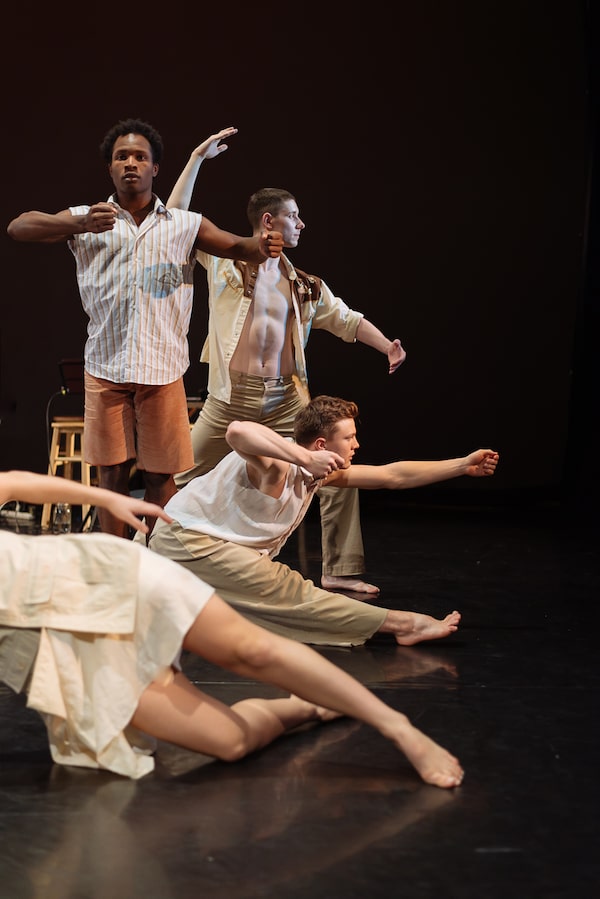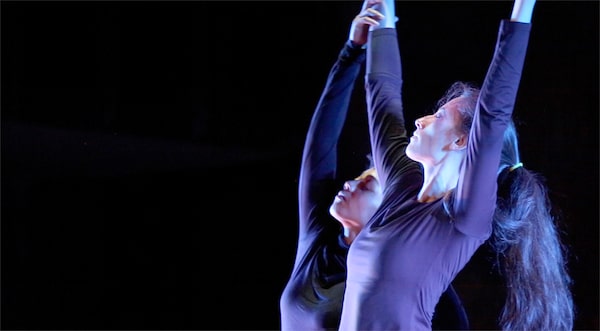Toronto Dance Theatre's Persefony Songs.Toronto Dance Theatre/Handout
- Persefony Songs
- Choreographed by Christopher House
- Music by Bernice, Thom Gill
- Presented by Toronto Dance Theatre
- World After Dark
- Choreographed by Shannon Litzenberger
- Music by John Gzowski
- Presented by Shannon Litzenberger Contemporary Dance
Christopher House’s recent body of work – Martingales, Echo and now Persefony Songs, which opened at Fleck Dance Theatre at Toronto’s Harbourfront on Tuesday night – are all textured and strikingly atmospheric creations. Each uses a large ensemble (12 dancers in Persefony) and develops task-based movement into greater motifs that evoke setting and mood. What sets the exquisite Persefony Songs apart is its stirring aura of tenderness.

Persefony Songs is inspired by the structure of The Odyssey and, to some degree, tells Persephone’s abduction story while evoking her personification of spring.Alejandro Santiago/handout
The 60-minute work is a reconceptualization of House’s Persephone’s Lunch (2000) and the last piece in Toronto Dance Theatre’s Reimagined Repertoire series. It’s inspired by the structure of The Odyssey and, to some degree, tells Persephone’s abduction story while evoking her personification of spring. The work picks up on certain choreographic qualities that have become key to House’s creations over the past few years. It is an act of presence as much as an act of movement. It is eventful before it is performative. It creates the sense of colloquy among its performers, as though the action moves forward because they agree to it, collectively, in real time.
Take the beginning sequence: Individual dancers hoist themselves on stage from the auditorium and slowly assume sensual poses that riff on classical themes. An arm is lifted and curved overhead as though it is being tested – is this comfortable? Expressive? Is it where I want to be? House seems to grant his dancers so much autonomy that you’d believe, should they be struck by a counterwhim, they’d simply drop their pose and walk offstage. Of course, this is a masterful illusion; House’s craftmanship is in absolute control.
In an upstage corner, the indie band Bernice plays beautiful medieval songs that are suffused with Thom Gill’s electronic compositions. Slats of wood hang from the rafters like broken windows and a long table covered in pomegranates – Persephone’s symbol – sits upstage (the set is designed by Steve Lucas and Simon Rossiter after James Robertson). Using ensemble configurations as simple as a long snaking line, the dancers feast, journey and go to war. A powerful sequence of duets seems to reprise ancient battle scenes. But there’s subversion here, or even a kind of cognitive dissonance wrought from conflicting physical ideas. As the dancers’ bodies attempt to peacefully negotiate poses of extreme violence, the poses are transformed into tableaus of intimacy. In what might have been the climax of a gruesome attack, a hand pressed against a face becomes profoundly sensual. The line between pain and pleasure is blurred and history undermined, re-envisioned.
When spring arrives, it’s vibrant and invigorating. The choreography propels itself into structured bursts of energy: winding jumps that needle toward the floor, lunges, turns. The company looks resplendent, each dancer fully themselves and fully present in this captivating work.

In World After Dark, dancers Emily Law and Kathia Wittenborn become a two-headed creature, at once foreboding and strange.Lyon Smith/handout
A second dance production currently at Harbourfront uses the device of personification more literally. Choreographer Shannon Litzenberger’s World After Dark imagines night as a woman (Linnea Swan) and places her in conflict with a workaday world of protocols and rules. Using text from Christopher Dewdney’s non-fiction book Acquainted with the Night, Litzenberger explores the duality of our diurnal and nocturnal identities.
There are compelling images in this piece, often ones that are developed in silence. Swan leans over a balcony upstage like a pining cabaret singer at midnight. In red and pink velvet bodysuits (designed by Alexandra Lord and Kleanthi Markakis) dancers Emily Law and Kathia Wittenborn become a two-headed creature, at once foreboding and strange as they traverse a dark landscape. Like a crepuscular moth drawn to the light, Wittenborn performs a sequence that brings an insect-like disjointedness to Litzenberger’s flowing choreography.
Persefony Songs and World After Dark continue at Toronto’s Harbourfront Centre until March 9.
Live your best. We have a daily Life & Arts newsletter, providing you with our latest stories on health, travel, food and culture. Sign up today.
 Martha Schabas
Martha Schabas